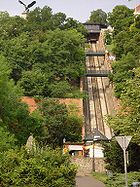
Budapest Castle Hill Funicular
Encyclopedia
.jpg)

Funicular
A funicular, also known as an inclined plane or cliff railway, is a cable railway in which a cable attached to a pair of tram-like vehicles on rails moves them up and down a steep slope; the ascending and descending vehicles counterbalance each other.-Operation:The basic principle of funicular...
in the city of Budapest
Budapest
Budapest is the capital of Hungary. As the largest city of Hungary, it is the country's principal political, cultural, commercial, industrial, and transportation centre. In 2011, Budapest had 1,733,685 inhabitants, down from its 1989 peak of 2,113,645 due to suburbanization. The Budapest Commuter...
, in Hungary
Hungary
Hungary , officially the Republic of Hungary , is a landlocked country in Central Europe. It is situated in the Carpathian Basin and is bordered by Slovakia to the north, Ukraine and Romania to the east, Serbia and Croatia to the south, Slovenia to the southwest and Austria to the west. The...
. It links the Adam Clark Square and the Széchenyi Chain Bridge
Széchenyi Chain Bridge
The Széchenyi Chain Bridge is a suspension bridge that spans the River Danube between Buda and Pest, the western and eastern sides of Budapest, the capital of Hungary...
at river level to Buda Castle
Buda Castle
Buda Castle is the historical castle and palace complex of the Hungarian kings in Budapest, first completed in 1265. In the past, it was also called Royal Palace and Royal Castle ....
above.
The line was opened on March 2, 1870, and has been in municipal ownership since 1920. It was destroyed in the Second World War
World War II
World War II, or the Second World War , was a global conflict lasting from 1939 to 1945, involving most of the world's nations—including all of the great powers—eventually forming two opposing military alliances: the Allies and the Axis...
and reopened on June 4, 1986. A feature of the line are the two pedestrian foot bridges which cross above it. These were present when the line opened, were removed in 1900 when the castle's garden was extended, and rebuilt to the original design in 1983.
The history of the railway
The building of the line started in the July of 1868, the first test run was on 23 October 1869. The Sikló has operated for the public since 2 March 1870. This funicular rail was the second in Europe, only LyonFuniculars of Lyon
The Funiculars of Lyon is a network of funicular railways in Lyon, France. Of the five lines once in existence, only the two routes on the Fourvière hill remain in operation, with the rest of the network now either closed, converted to road vehicle use, or integrated within the Lyon underground...
had a similar transportation system at that time.
During the Second World War
World War II
World War II, or the Second World War , was a global conflict lasting from 1939 to 1945, involving most of the world's nations—including all of the great powers—eventually forming two opposing military alliances: the Allies and the Axis...
the cars and the terminals were destroyed by bombs.
Technical parameters
The line has the following technical parameters:- Length: 95 metres
- Height: 51 metres
- Maximum gradient: 48%
- Cars: 2
- Capacity: 24 passengers per car
- Configuration: Double track
- Maximum speed: 1.5 metres per second
- Track gauge: Standard gauge
- Traction: Electricity
- Trip time: 1 1/2 minutes
The line is operated by the BKV
BKV
BKV is the unified public transport company of Budapest, established in 1968...
(Mass Transport Company of Budapest), and operates from 07.30 to 22.00 each day.

